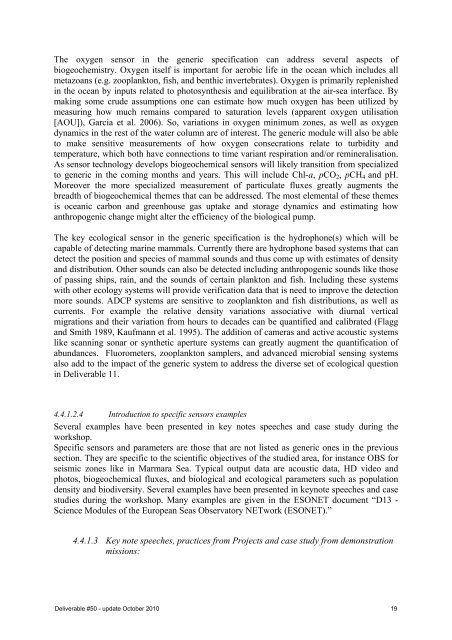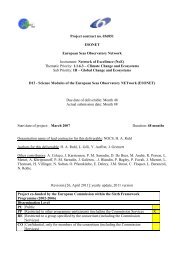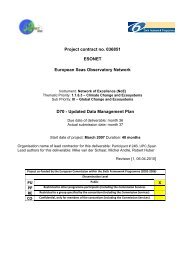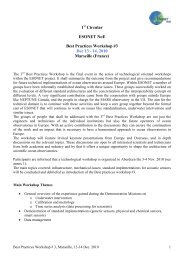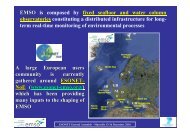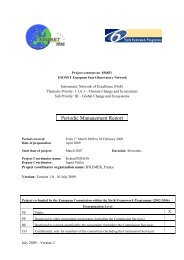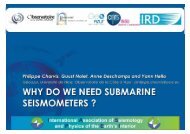Project Deliverable D50 Report on Best Practices ... - ESONET NoE
Project Deliverable D50 Report on Best Practices ... - ESONET NoE
Project Deliverable D50 Report on Best Practices ... - ESONET NoE
Create successful ePaper yourself
Turn your PDF publications into a flip-book with our unique Google optimized e-Paper software.
The oxygen sensor in the generic specificati<strong>on</strong> can address several aspects of<br />
biogeochemistry. Oxygen itself is important for aerobic life in the ocean which includes all<br />
metazoans (e.g. zooplankt<strong>on</strong>, fish, and benthic invertebrates). Oxygen is primarily replenished<br />
in the ocean by inputs related to photosynthesis and equilibrati<strong>on</strong> at the air-sea interface. By<br />
making some crude assumpti<strong>on</strong>s <strong>on</strong>e can estimate how much oxygen has been utilized by<br />
measuring how much remains compared to saturati<strong>on</strong> levels (apparent oxygen utilisati<strong>on</strong><br />
[AOU]), Garcia et al. 2006). So, variati<strong>on</strong>s in oxygen minimum z<strong>on</strong>es, as well as oxygen<br />
dynamics in the rest of the water column are of interest. The generic module will also be able<br />
to make sensitive measurements of how oxygen c<strong>on</strong>secrati<strong>on</strong>s relate to turbidity and<br />
temperature, which both have c<strong>on</strong>necti<strong>on</strong>s to time variant respirati<strong>on</strong> and/or remineralisati<strong>on</strong>.<br />
As sensor technology develops biogeochemical sensors will likely transiti<strong>on</strong> from specialized<br />
to generic in the coming m<strong>on</strong>ths and years. This will include Chl-a, pCO2, pCH4 and pH.<br />
Moreover the more specialized measurement of particulate fluxes greatly augments the<br />
breadth of biogeochemical themes that can be addressed. The most elemental of these themes<br />
is oceanic carb<strong>on</strong> and greenhouse gas uptake and storage dynamics and estimating how<br />
anthropogenic change might alter the efficiency of the biological pump.<br />
The key ecological sensor in the generic specificati<strong>on</strong> is the hydroph<strong>on</strong>e(s) which will be<br />
capable of detecting marine mammals. Currently there are hydroph<strong>on</strong>e based systems that can<br />
detect the positi<strong>on</strong> and species of mammal sounds and thus come up with estimates of density<br />
and distributi<strong>on</strong>. Other sounds can also be detected including anthropogenic sounds like those<br />
of passing ships, rain, and the sounds of certain plankt<strong>on</strong> and fish. Including these systems<br />
with other ecology systems will provide verificati<strong>on</strong> data that is need to improve the detecti<strong>on</strong><br />
more sounds. ADCP systems are sensitive to zooplankt<strong>on</strong> and fish distributi<strong>on</strong>s, as well as<br />
currents. For example the relative density variati<strong>on</strong>s associative with diurnal vertical<br />
migrati<strong>on</strong>s and their variati<strong>on</strong> from hours to decades can be quantified and calibrated (Flagg<br />
and Smith 1989, Kaufmann et al. 1995). The additi<strong>on</strong> of cameras and active acoustic systems<br />
like scanning s<strong>on</strong>ar or synthetic aperture systems can greatly augment the quantificati<strong>on</strong> of<br />
abundances. Fluorometers, zooplankt<strong>on</strong> samplers, and advanced microbial sensing systems<br />
also add to the impact of the generic system to address the diverse set of ecological questi<strong>on</strong><br />
in <str<strong>on</strong>g>Deliverable</str<strong>on</strong>g> 11.<br />
4.4.1.2.4 Introducti<strong>on</strong> to specific sensors examples<br />
Several examples have been presented in key notes speeches and case study during the<br />
workshop.<br />
Specific sensors and parameters are those that are not listed as generic <strong>on</strong>es in the previous<br />
secti<strong>on</strong>. They are specific to the scientific objectives of the studied area, for instance OBS for<br />
seismic z<strong>on</strong>es like in Marmara Sea. Typical output data are acoustic data, HD video and<br />
photos, biogeochemical fluxes, and biological and ecological parameters such as populati<strong>on</strong><br />
density and biodiversity. Several examples have been presented in keynote speeches and case<br />
studies during the workshop. Many examples are given in the <strong>ESONET</strong> document “D13 -<br />
Science Modules of the European Seas Observatory NETwork (<strong>ESONET</strong>).”<br />
4.4.1.3 Key note speeches, practices from <str<strong>on</strong>g>Project</str<strong>on</strong>g>s and case study from dem<strong>on</strong>strati<strong>on</strong><br />
missi<strong>on</strong>s:<br />
<str<strong>on</strong>g>Deliverable</str<strong>on</strong>g> #50 - update October 2010 19


